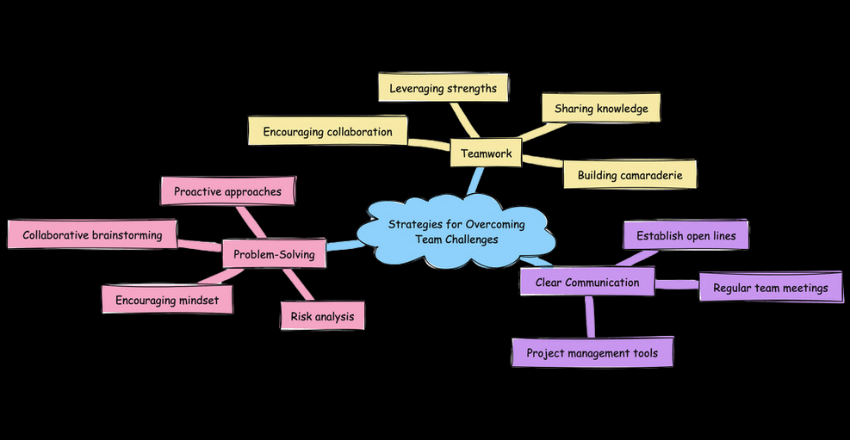Web development teams often encounter various challenges that can hinder their productivity and impact the overall success of a project. From managing a large team to balancing client expectations and ensuring web application security, these challenges require careful attention and strategic solutions.
Managing Effective Communication in a Large Team
When working with a large web development team, one of the main challenges is managing effective communication to maintain collaboration and ensure the smooth progress of the project. In such teams, it is crucial to establish clear communication channels and regularly check in with team members to ensure everyone is aligned and working towards the same goals.
Regular check-ins can take various forms, such as daily stand-up meetings, weekly progress updates, or project management tools that facilitate communication and collaboration. These check-ins allow team members to share updates, discuss any challenges or roadblocks, and align their efforts to ensure the project stays on track.
Furthermore, effective communication in a large team also involves providing clarity and transparency. Clearly defining roles and responsibilities, setting expectations, and ensuring everyone has access to the information they need promotes a sense of ownership and accountability while minimizing misunderstandings or duplication of work.
Managing effective communication in a large web development team is essential for fostering collaboration, ensuring everyone is on the same page, and maximizing productivity. By establishing clear communication channels, conducting regular check-ins, and promoting transparency, teams can overcome this challenge and work harmoniously towards achieving project success.
Balancing Client Expectations and Realistic Goals

Meeting client expectations while maintaining realistic goals can be a significant challenge in web development projects. Clients often have specific requests and high expectations for their websites or applications, which may not always align with the constraints and limitations of the development process. Effective communication and managing expectations are key to finding a balance that ensures client satisfaction while also delivering a successful project.
One approach to managing client expectations is to establish clear and open lines of communication from the start. Regular check-ins and progress updates allow for ongoing dialogue between the development team and the client, providing opportunities to discuss any changes or modifications that may be necessary. By maintaining transparency and keeping the client informed throughout the development process, misunderstandings and unrealistic expectations can be avoided.
Another important aspect of managing client expectations is setting realistic goals and timelines. It is essential to have a clear understanding of the project scope, technical limitations, and potential challenges before making commitments to the client. By setting realistic expectations from the beginning, both parties can work together to prioritize and focus on achievable goals, ensuring a smooth development process and ultimately a successful outcome.
| Effective Strategies for Managing Client Expectations |
|---|
| 1. Clear and open communication |
| 2. Regular check-ins and progress updates |
| 3. Setting realistic goals and timelines |
| 4. Managing client expectations through ongoing dialogue |
Successfully balancing client expectations and realistic goals in web development projects requires effective communication, transparent collaboration, and setting clear expectations from the start. By managing client expectations through open dialogue and regular check-ins, and by setting achievable goals and timelines, web development teams can deliver high-quality results that meet both the client’s needs and the realities of the development process.
Prioritizing Web Application Security

In today’s digital landscape, creating safe web applications is a critical challenge for web development teams. With cybersecurity threats becoming increasingly sophisticated, it is essential for teams to prioritize security measures from the very beginning of the development process. By doing so, they can mitigate risks and protect sensitive data, earning the trust of their clients and users.
One effective way to prioritize web application security is by conducting thorough vulnerability assessments and penetration testing. This involves identifying potential weaknesses in the application’s code and infrastructure and testing its defenses against simulated cyber-attacks. By regularly conducting these tests, teams can proactively identify and address security vulnerabilities, ensuring that their applications are robust and resistant to potential threats.
Another crucial aspect of web application security is implementing strong authentication and authorization mechanisms. This includes enforcing strong password policies, implementing multi-factor authentication, and restricting access based on user roles and privileges. By implementing these measures, teams can prevent unauthorized access to sensitive data, reducing the risk of data breaches and unauthorized modifications.
| Web Application Security Best Practices | Description |
|---|---|
| Regular security updates and patches | Keep the application’s software and libraries up to date to prevent exploitation of known vulnerabilities. |
| Encrypting sensitive data | Implement encryption protocols to protect sensitive user data during transit and storage. |
| Secure coding practices | Follow coding guidelines and frameworks that promote secure coding practices, such as input validation and output encoding. |
| Monitoring and logging | Implement robust monitoring and logging systems to detect and respond to potential security incidents. |
Lastly, educating the development team on web application security best practices is crucial. By providing training and workshops on secure coding practices, common attack vectors, and emerging threats, teams can equip their developers with the knowledge and skills to build secure applications. This ongoing education helps foster a security-conscious mindset within the team, promoting a culture of vigilance and proactive security measures.
Harmonizing Front-end and Back-end Development
The collaboration between front-end and back-end developers can present challenges that need to be overcome for a successful web development project. Front-end developers are responsible for creating the visual and interactive elements of a website, while back-end developers handle the server-side programming and database management. Both roles are crucial for delivering a cohesive and functional website, but their different focuses can sometimes lead to conflicts and miscommunication.
Effective collaboration between front-end and back-end developers requires open and clear communication channels. Regular check-ins and meetings can help ensure that both teams are aligned in their goals and objectives. This allows for better understanding of each team’s requirements and priorities, enabling them to work together more efficiently.
Compromise is also essential in harmonizing front-end and back-end development. Both teams need to be willing to make adjustments and find middle ground to achieve a balance between design and functionality. This may involve discussions about technical limitations, user experience considerations, and overall project scope. By finding common ground and working together, front-end and back-end developers can create a seamless and optimized web application.
| Challenges | Solutions |
|---|---|
| Different visions between front-end and back-end developers | Open and clear communication, compromise |
| Technical limitations and user experience considerations | Collaborative problem-solving, finding common ground |
| Understanding project scope and priorities | Regular check-ins, defining clear objectives |
In summary, harmonizing front-end and back-end development in web projects can be challenging but achievable. By emphasizing communication, compromise, and a shared understanding of project goals, teams can work together effectively to create successful web applications. It is crucial to foster a collaborative environment that values the contributions of both front-end and back-end developers, ultimately delivering high-quality results and exceptional user experiences.
Strategies for Overcoming Team Challenges

Overcoming team challenges in web development requires implementing effective strategies and fostering a collaborative work environment. By utilizing the following strategies, web development teams can navigate these challenges and achieve successful outcomes.
- Clear Communication: Establishing clear and open lines of communication is essential for effective collaboration. Regular team meetings, check-ins, and utilizing project management tools can help ensure everyone is on the same page and can address any issues or concerns in a timely manner.
- Problem-Solving: Encouraging a problem-solving mindset within the team can help overcome hurdles. Collaboratively brainstorming solutions, analyzing potential risks, and taking a proactive approach to addressing challenges can lead to innovative and efficient problem-solving.
- Teamwork: Building a strong sense of teamwork and camaraderie among team members fosters a positive work environment. Encouraging collaboration, sharing knowledge and resources, and leveraging individual strengths can contribute to improved team dynamics and ultimately increase productivity.
To further enhance team performance, dedicating time for team-building activities and fostering a culture of continuous learning can go a long way. By investing in the growth and development of each team member, web development teams can stay ahead of industry trends and deliver high-quality solutions.
Examples: Successful Solutions to Web Development Challenges
| Challenge | Solution | Results |
|---|---|---|
| Communication breakdown in a large team | Implemented regular stand-up meetings and utilized project management tools | Improved coordination, reduced errors, and enhanced team collaboration |
| Managing unrealistic client expectations | Established clear communication channels and set realistic timelines | Enhanced client satisfaction and managed expectations effectively |
| Harmonizing front-end and back-end development | Implemented cross-functional collaboration and regular communication between developers | Delivered a cohesive end product that met client requirements |
These examples demonstrate the effectiveness of implementing strategies, such as improved communication, setting realistic expectations, and fostering collaboration, in overcoming team challenges in web development projects.
The Role of Outsourcing Companies in Addressing Team Challenges
Outsourcing companies like BizCoder play a crucial role in helping businesses overcome team challenges in web development projects. These challenges can range from managing a large team to balancing client expectations and addressing cybersecurity threats. By partnering with an experienced outsourcing company, businesses can leverage their expertise and resources to effectively navigate these obstacles and achieve successful outcomes.
One of the main advantages of outsourcing web development tasks is the ability to tap into a diverse talent pool. Outsourcing companies have teams of skilled professionals who specialize in different areas of web development, including front-end and back-end development, UI/UX design, and quality assurance. This expertise allows them to handle complex projects and address the specific challenges that arise during the development process.
Collaboration is key in web development, and outsourcing companies excel in fostering effective collaboration between different team members. They have well-established communication channels and project management systems in place to ensure seamless coordination between in-house teams and the outsourced team. Regular check-ins, status updates, and clear communication channels help keep everyone aligned and working towards the same goals.
Moreover, outsourcing companies prioritize security in web development projects. They are well-versed in cybersecurity best practices and implement robust security measures from the beginning of the development process. This ensures that web applications are safe and protected against potential threats, providing businesses and their clients with peace of mind.
| Benefits of Outsourcing Companies in Web Development Projects |
|---|
| Access to a diverse talent pool |
| Expertise in handling complex projects and challenges |
| Effective communication and collaboration |
| Prioritization of web application security |
| Cost-effectiveness and time savings |
Outsourcing companies like BizCoder provide businesses with the necessary support and expertise to overcome team challenges in web development projects. Their ability to tap into a diverse talent pool, foster effective communication and collaboration, and prioritize security make them valuable partners in achieving success and delivering high-quality web applications.
Wrapping up
While web development teams may face various challenges, by implementing effective strategies and fostering collaboration, they can overcome these hurdles and achieve success in their projects.
Managing a large team is no easy task, but with regular check-ins and clear communication channels, web development teams can ensure that all members are aligned and working towards the same goals. Balancing client expectations with realistic goals is another challenge, but through effective communication and setting realistic timelines, teams can manage client requests and deliver satisfactory results.
External Sources
https://www.linkedin.com/advice/0/how-do-you-stay-motivated-overcome-web-development
https://www.ironhack.com/ww/en/blog/overcoming-challenges-in-web-development-tips-and-strategies











